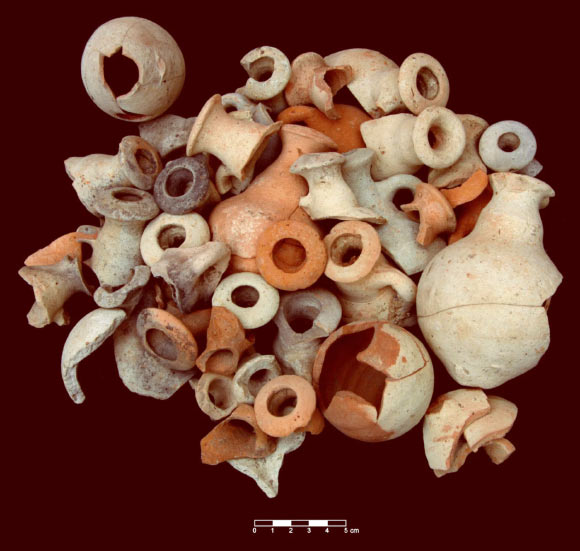Archaeologists have performed the first systematic, interdisciplinary analysis of the composition, technology, and contents of 51 ‘Phoenician oil bottles’ from the island of Motya, off the west coast of Sicily, Italy. Their results suggest that aromatic unguents were likely produced and bottled in southern Phoenicia during the 8th-6th centuries BCE and circulated to the western Mediterranean.

A selection of ‘Phoenician oil bottles’ (c. 750/740-550/530 BCE) from Motya, Italy. Image credit: A. Orsingher.
The Phoenicians employed aromatic substances in diverse ways. They were often burned in ceramic, metal, or stone supports, imparting specific sensory qualities to indoor and outdoor spaces, suggesting the enactment of particular ritual practices and more.
The stereotypical image of smoke rising from incense burners before divine figures or symbols is frequently depicted in Phoenician iconography.
Furthermore, the common vegetal decoration or floral morphology of incense burners explicitly illustrates the synesthetic link between scents and the vessels’ function.
Among Phoenician ceramics associated with scented substances, a group of small, undecorated vessels known as ‘Phoenician oil bottles’ stands out.
Although not part of a standardized production, these juglets, dating to the 8th-6th centuries BCE, are typically characterized by narrow mouths with thick, outward-sloping rims; short, bulging necks that taper in diameter; a single vertical ring handle, rounded in section, attached at the mid-neck and shoulder; globular to ovoid bodies; and ringed, pointed, or rounded bases.
Except for the notably large examples from the Teatro Cómico in Cádiz, Phoenician oil bottles generally range in height from 11.5 to 14 cm and in maximum diameter from 8.5 to 10 cm until approximately the mid-7th century BCE.
Thereafter, the height decreases to around 9.5 cm and the body to approximately 6.5 cm, accompanied by a reduction in the handle’s size, such that it no longer allows a finger to pass through.
These plain ware, slow-pouring juglets have been recovered from various contexts across the Atlantic and Mediterranean regions, including tombs, houses, sacred areas, pottery workshops, and a shipwreck. This distribution reflects their widespread and varied use.
The small island of Motya in western Sicily, Italy, currently yields the largest number of these vessels.
“Their widespread distribution across and beyond the Mediterranean suggests these vessels fulfilled diverse functions,” said Dr. Adriano Orsingher, a researcher at the Complutense University of Madrid and the Institute of Biblical Archaeology at the University of Tübingen.
In the new study, Dr. Orsingher and colleagues examined the composition of the ceramics to determine the origin of ‘Phoenician oil bottles.’
Further analysis of the organic residues preserved within the vessels provided insight into their original contents and intended use.
Their results point to a production origin in southern Phoenicia, specifically between present-day Beirut and the Carmel region.
Organic residues were detected in eight of the 51 vessels, revealing traces of plant-based lipids, as well as pine and mastic resin, which are strong indicators of fragrant oil preparations.
“Our research confirms these ceramic vessels were used to transport aromatic oils,” said Dr. Silvia Amicone, a researcher at the University of Tübingen.
“These oils were more than simple commodities. They functioned as cultural connectors, as expressions of identity that accompanied Phoenician migrants across the Mediterranean,” Dr. Orsingher said.
“Carrying scents of home, they served as instruments of memory and reinforced shared practices and olfactory experiences among dispersed communities.”
The Iron Age Mediterranean was a landscape of intense mobility, trade, and cultural entanglement.
Among the key agents of this connectivity were the Phoenicians, renowned sailors, traders, artisans, and migrants who established settlements far beyond their Levantine homeland.
Integral to Phoenician cultural practices was the production and use of aromatic substances, both for local use and export.
The study calls for a broader reconsideration of how migration, trade, and cultural belonging were experienced in the ancient world.
“We must rethink ancient mobility, not just as the movement of people and goods, but as the circulation of smells, memories, and sensory traditions,” Dr. Orsingher said.
“Scent is intimately tied to identity. As such, it plays a crucial, though often overlooked, role in processes of migration, settlement, and cultural exchange.”
“Our work highlights the potential of interdisciplinary science to unlock the intangible dimensions of antiquity,” Dr. Amicone said.
“By studying what these vessels contained and how they were used, we gain unique insights into how scents connected lives, landscapes, and identities in the ancient Mediterranean,” Dr. Orsingher said.
“Innovative research approaches continue to uncover surprising insights into the past,” said University of Tübingen’s Professor (Dōshisha) Karla Pollmann.
“This study shows how even elusive traces like ancient scents can be made accessible through interdisciplinary methods, opening new windows into the sensory and cultural worlds of antiquity.”
The findings were published in the Journal of Archaeological Method and Theory.
_____
A. Orsingher et al. 2025. Scents of Home: Phoenician Oil Bottles from Motya. J Archaeol Method Theory 32, 59; doi: 10.1007/s10816-025-09719-3







